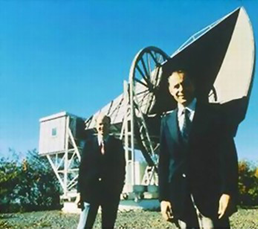- 1610: Galileo
- 1676: Ole Rømer
- 1687: Isaac Newton
- 1781: William Herschel
- 1838: Friedrich Bessel
- 1861: William and Margaret Huggins
- 1912: Henrietta Leavitt
- 1917 Einstein
- 1920: Harlow Shapley
- 1929 Edwin Hubble
- 1948: Ralph Alpher
- 1949: Fred Hoyle
- 1963: Maarten Schmidt
- 1964: Arno Penzias and Robert Wilson
- 1978: Vera Rubin and Kent Ford
- 1989: Margaret Geller and John Huchra
- 1992: John Mather and George Smoot
- 1995: Robert Williams
- 1998: Saul Perlmutter and Brian Schmidt
- 2010: Wendy Freedman
1964: Arno Penzias and Robert Wilson Find Evidence in Support of the Big Bang
 In 1948 Ralph Alpher and Robert Herman published a prediction that if indeed the universe were created in a Big Bang, today we would see the glow of light that was released when atoms first formed, when the universe was about 300,000 years old. Since the universe has been expanding for billions of years,the light would have been redshifted by a factor of 1,000, so that it could only be detected today as microwaves. In 1964 Arno Penzias and Robert Wilson of Bell Labs announced they had identified this light, providing the strongest evidence to date in support of the Big Bang theory.
In 1948 Ralph Alpher and Robert Herman published a prediction that if indeed the universe were created in a Big Bang, today we would see the glow of light that was released when atoms first formed, when the universe was about 300,000 years old. Since the universe has been expanding for billions of years,the light would have been redshifted by a factor of 1,000, so that it could only be detected today as microwaves. In 1964 Arno Penzias and Robert Wilson of Bell Labs announced they had identified this light, providing the strongest evidence to date in support of the Big Bang theory.
The science of radio astronomy began in 1928, when AT&T began transatlantic radio communications. In an attempt to reduce the background hiss and crackle that sometimes interfered with the signals, the company hired 22 year-old Karl Jansky to find the source of the bothersome noise. Jansky built a radio antenna and managed to trace most of the noise to the lightning in thunderstorms. However, some of the noise could not be explained. Through careful investigation he noted that a faint hiss came from a certain region of the sky and peaked at an interval of 23 hours and 56 minutes. A colleague pointed out that the period of the signal corresponded to a sidereal day—the length of time that the stars come back into the same alignment as the day before. Jansky was the first person to observe a source of radio waves from space. Eventually it turned out to be radio waves emitted from the center of our Milky Way galaxy.